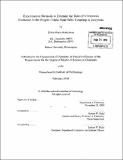Experimental methods to examine the role of vibrational excitation in the singlet-triplet spin-orbit coupling in acetylene
Author(s)
Robertson, Erika Marie
DownloadFull printable version (2.246Mb)
Other Contributors
Massachusetts Institute of Technology. Dept. of Chemistry.
Advisor
Robert W. Field.
Terms of use
Metadata
Show full item recordAbstract
Despite being a seemingly simple molecule, acetylene has a complicated electronic structure that has been studied extensively both experimentally and theoretically. Acetylene has been observed to have a complex spin-orbit coupling mechanism where the first excited singlet state S couples to the triplet state T3 which is then coupled to the dense manifold of vibrational states in the T, 2 electronic states. A description of theories imperative to this study is provided and each is related to its application in experiment. A description of how to obtain important parameters in the coupling, such as the coupling strength, the singlet-triplet mixing fraction, the radiative lifetime, and the relative energy ordering and separation between the singlet and coupled triplet, is given. Finally, key vibrational levels of interest that should be investigated are described.
Description
Thesis (S.M.)--Massachusetts Institute of Technology, Dept. of Chemistry, 2010. Cataloged from PDF version of thesis. Includes bibliographical references (p. 46-49).
Date issued
2010Department
Massachusetts Institute of Technology. Department of ChemistryPublisher
Massachusetts Institute of Technology
Keywords
Chemistry.